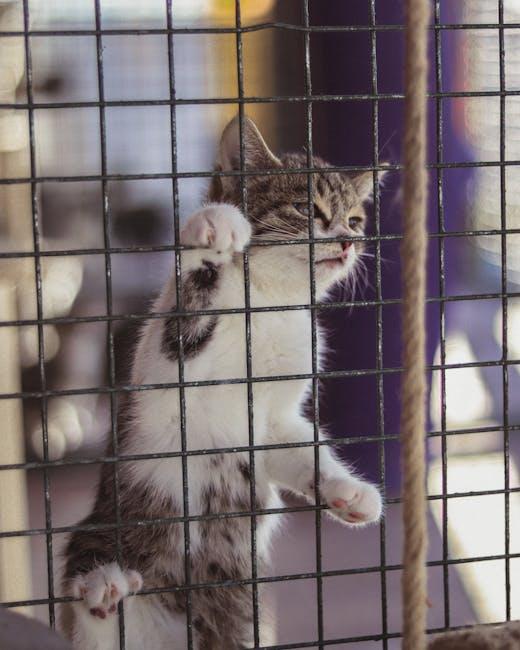For many cat owners, ensuring their feline companions feel safe and comfortable is a top priority. One effective tool in achieving this is the humble cat cage. Whether you’re introducing a new kitten to an older cat, traveling, or simply providing a secure space for your pet, a cat cage can be an invaluable asset. In this article, we’ll delve into the various uses and benefits of cat cages, share expert tips on selecting the right cage for your feline friend, and explore the best practices for making your cat’s transition into the cage as smooth and stress-free as possible. So, let’s embark on this journey together and discover how a cat cage can enhance both your life and your cat’s wellbeing.
Table of Contents
- Understanding the Importance of a Cat Cage and How It Benefits Your Feline Friend
- Choosing the Right Cat Cage: Key Features to Look For
- Setting Up the Perfect Cat Cage Environment
- Training Your Cat to Love Their Cage: Expert Tips and Techniques
- Q&A
- Wrapping Up
Understanding the Importance of a Cat Cage and How It Benefits Your Feline Friend
A cat cage might sound restrictive at first, but it can play an invaluable role in ensuring your feline’s safety and well-being. Primarily, a cat cage provides a controlled environment where you can manage your pet’s movement, particularly in situations that might be overwhelming or dangerous for them. For instance, during travel or visits to the vet, a cage ensures that your cat remains calm and secure, reducing stress for both of you.
Furthermore, a cat cage is essential for training purposes. Whether you’re crate training to help your cat become accustomed to confinement or using the cage as part of a behavioral adjustment program, the structured space can encourage better habits and reduce anxiety. It’s crucial to differentiate from dog crate training, as cats require a more nuanced approach that respects their unique behavioral patterns. Unlike dogs, cats need a space that feels safe and cozy, perhaps with familiar toys or a soft blanket [[2]].
Additionally, in multi-pet households, a cat cage can serve as a sanctuary. If you have other animals like dogs or even guinea pigs, a cage provides a safe haven where your cat can retreat when needed. This becomes particularly important if there’s a need to separate pets due to health issues or during acclimation periods [[1]]. The cage can thus prevent conflicts and ensure that each pet has its own space.
| Situation | Benefit of Cat Cage |
|---|---|
| Traveling | Ensures safety and reduces stress |
| Training | Helps in behavioral adjustments |
| Multi-pet Household | Acts as a sanctuary and prevents conflicts |
In shelters, where space might be limited, cat cages are indispensable in preventing the spread of illnesses. They provide individual spaces for cats, which is crucial in reducing cross-contamination and ensuring each cat receives proper care. By isolating sick cats, cages can help manage health within the shelter and improve overall adoption success rates [[3]].
Ultimately, a cat cage isn’t just a tool for confinement; it’s a multifunctional accessory that enhances your cat’s life when used appropriately. With thoughtful integration into your cat care routine, it can promote safety, health, and proper behavior, making it an essential part of modern pet care.

Choosing the Right Cat Cage: Key Features to Look For
Finding the perfect cat cage involves considering various key features to ensure the comfort and safety of your feline friend. One of the most crucial aspects to look for is durability and stability. The cage should be made of high-quality, robust materials that can withstand your cat’s natural behavior, such as scratching and playing. Look for cages with sturdy construction, preferably with reinforced corners and escape-proof locks to prevent any adventurous escapes.
Another important feature is the size and space the cage offers. Cats need room to move around, stretch, and play. Opt for a cage that provides ample space not just for standing and lounging but also for placing essential items like litter boxes, food, and water dishes. Multi-level cages can be excellent for added exercise and stimulation, giving your cat more vertical space to explore.
Ventilation and visibility are also vital factors. Ensure the cage has plenty of air circulation to keep your pet cool and comfortable. Transparent walls or wire mesh designs are great options as they allow your cat to see out and keep engaged with their surroundings, reducing stress and anxiety. Plus, it allows you to keep an eye on them easily.
When it comes to convenience, ease of cleaning cannot be overlooked. Choose a cage with removable trays and washable surfaces to make maintenance a breeze. Additionally, look for cages with multiple access doors so you can easily reach in to clean or interact with your pet without any hassle.
| Feature | Considerations |
|---|---|
| Durability | High-quality materials, escape-proof locks |
| Size & Space | Ample room, multi-levels for stimulation |
| Ventilation & Visibility | Good air circulation, transparent or mesh walls |
| Ease of Cleaning | Removable trays, washable surfaces, multiple access doors |
Lastly, think about the portability and storage of the cage. If you plan to travel with your cat, a collapsible or foldable design can be very practical. Additionally, some cages feature built-in wheels or handles, making it easier to move around the house or even outdoors when needed.
Choosing the right cat cage is crucial for your pet’s wellbeing and your peace of mind. By prioritizing these key features, you can provide a safe, comfortable, and stimulating environment for your beloved feline companion.

Setting Up the Perfect Cat Cage Environment
Creating a comfortable and stimulating environment within a cat cage is essential for your feline friend’s well-being. Here are some key considerations to ensure that your cat’s cage is a safe, enjoyable space.
Comfort and Softness
Your cat’s comfort should be a top priority. Line the cage with soft bedding, such as a cozy blanket or a plush cat bed. This not only provides a comfortable resting place but also helps in managing stress, particularly in new environments. Regularly clean and change the bedding to keep it fresh.
Essential Amenities
Ensure that the cage is equipped with all the essentials your cat might need:
- Fresh Water: Keep a bowl or a non-spill water dispenser filled with clean water.
- Food Bowl: A sturdy bowl for food that is easy to clean and stable.
- Litter Box: Incorporate a small litter box with a low entry for easy access. Opt for a corner design to maximize space.
Mental Stimulation
Cats are naturally curious and need mental stimulation to avoid boredom. Include a variety of toys that can keep your cat entertained:
- Interactive Toys: Such as balls with bells or small plush toys with catnip.
- Scratching Posts: If space allows, a small scratching post can be a great addition.
- Hideaways: Provide a small hideaway area where your cat can retreat and feel secure.
Below is an example table outlining these essentials:
| Essential | Description |
|---|---|
| Bedding | Soft, washable blanket or cat bed |
| Water | Fresh water dispenser or bowl |
| Food | Sturdy, easy-to-clean bowl |
| Litter Box | Corner design, low entry |
| Toys | Interactive or catnip-filled toys |
| Hideaway | Small, secure retreat space |
Cleanliness and Hygiene
Maintaining cleanliness is crucial. Regularly clean the litter box and ensure there is no spilled food or water. Disinfect the cage weekly with pet-safe cleaners to prevent any build-up of bacteria, which is especially important in managing stress and health issues like cryptosporidiosis in shelter settings [[3]].
By focusing on comfort, essential amenities, mental stimulation, and cleanliness, you create an environment in the cage that supports both the physical and emotional well-being of your cat.
Training Your Cat to Love Their Cage: Expert Tips and Techniques
Ensuring your cat feels comfortable in their cage can transform travel and vet visits from stressful episodes into serene experiences. Here are expert tips and techniques to make your feline friend fall in love with their new haven.
Begin with Familiarization
Introduce the cage to your cat by placing it in a common area of your home. Allow your cat to explore it at their own pace. Make the space inviting by placing a soft blanket or one of your cat’s favorite toys inside. You can even sprinkle in some catnip to attract their interest and create positive associations. Remember, the goal is to make the carrier a part of their everyday environment rather than a symbol of something foreign or stressful.
Positive Reinforcement
Reward your cat for showing interest in the cage. Use treats and affection to encourage them to enter and spend time inside. Each step closer deserves recognition—whether it’s poking a nose inside the door or sitting at the entrance. According to Life With Cats, incorporating reward-based training sessions can significantly ease the process. Keep sessions short and consistent to avoid overwhelming your cat.
| Training Stage | Reward Type | Goal |
|---|---|---|
| Initial Exploration | Treats & Toys | Familiarity |
| Entering Cage | Verbal Praise & Treats | Positive Association |
| Staying Inside | Extended Playtime | Comfort |
Create a Routine
Routine is crucial for cats. Incorporate cage time into your daily activities. For instance, set specific times when your cat will get their favorite treats only when inside the cage. This predictable schedule helps reduce anxiety and builds a habit where the cage becomes associated with positive experiences. Consistency and patience are key, as stated in resources like Pet Relocation.
Comfort Enhancements
Ensure the cage is a safe and cozy sanctuary. Use soft bedding and keep the interior clean. During travel, covering the cage with a light blanket can create a peaceful, den-like space, reducing external stimuli that might cause stress. Regularly check and refresh the bedding to maintain a pleasant environment, making the cage a true extension of your cat’s safe zone.
Q&A
### Q&A: Understanding and Managing Your Cat’s Cage
Q1: Why might I need a cat cage for my pet?
A: Cat cages can be incredibly useful for a variety of situations. They provide a safe and contained space for your cat during travel, vet visits, or when introducing them to new environments. Additionally, if you are dealing with behavioral issues or need to keep your cat away from certain areas temporarily, a cat cage can be an effective solution.
Q2: How do I choose the right cat cage for my feline friend?
A: Selecting the right cage depends on several factors, including the size of your cat, the intended use, and your cat’s comfort. Ensure the cage is spacious enough for your cat to stand, turn around, and lie down comfortably. Look for cages with sturdy construction, good ventilation, and easy access points for feeding and cleaning.
Q3: Is it cruel to keep my cat in a cage?
A: Using a cage is not inherently cruel if it is done properly and for the right reasons. It is essential to use the cage as a tool for safety and management rather than punishment. Make sure your cat has access to food, water, and a comfortable resting area inside the cage. Limiting time spent in the cage and ensuring regular interaction and exercise are crucial to maintaining your cat’s well-being.
Q4: What should I include in my cat’s cage to ensure their comfort?
A: Enhancing your cat’s comfort in the cage can be achieved by including a soft bed or blanket, their favorite toys, and a small litter box if the cage is large enough. Additionally, having water and food dishes attached to the cage can make feeding time more convenient and less messy.
Q5: How can I help my cat adjust to being in a cage?
A: Gradual introduction is key to helping your cat adjust to the cage. Start by allowing your cat to explore the cage with the door open, placing treats and toys inside to create a positive association. Gradually increase the time your cat spends inside the cage with the door closed, ensuring they remain calm and comfortable throughout the process.
Q6: What should I do if my cat seems stressed while in the cage?
A: If your cat appears stressed, it’s important to address their discomfort promptly. Providing a soothing environment by covering the cage with a blanket to reduce visual stimuli can help. Additionally, engaging them with calming activities, such as gentle petting or giving them treats, can reassure your cat. If stress persists, consult your veterinarian for further advice.
Q7: Can I use a cat cage to introduce my cat to other pets?
A: Yes, a cat cage can be an effective tool for safely introducing your cat to new pets. Initially, keep your cat in the cage while allowing the other pet to approach. This setup allows them to see and smell each other without the risk of aggression or injury. Gradually increase their exposure under supervision until they become more comfortable with each other.
For more information on how to manage your pet’s interactions and well-being, you can refer to resources specifically focused on pet behavior and care, such as those found on Animal League’s website [[1]].
Wrapping Up
selecting the perfect cat cage is not just about meeting the basic needs of your feline companion; it’s about ensuring they have a comfortable, secure, and enriching environment. Whether you need a cage for travel, a temporary stay, or as a safe haven within your home, remember that the right choice will enhance your cat’s well-being and provide peace of mind for you. Take the time to consider all aspects, from size and material to added features that cater to your cat’s personality and needs. Happy cat, happy home – that’s the ultimate goal.
Thank you for joining us on this exploration of what makes the ideal cat cage. We hope this guide has been helpful, and we encourage you to share your experiences and tips with other cat lovers. Here’s to creating a perfect space for every whiskered friend out there!







0 Comments